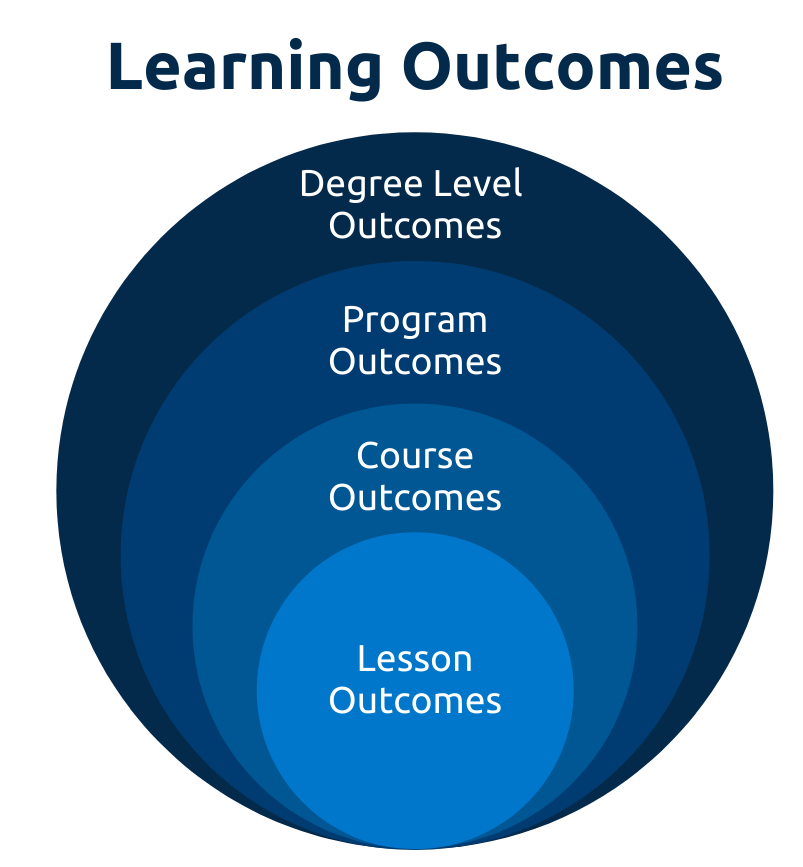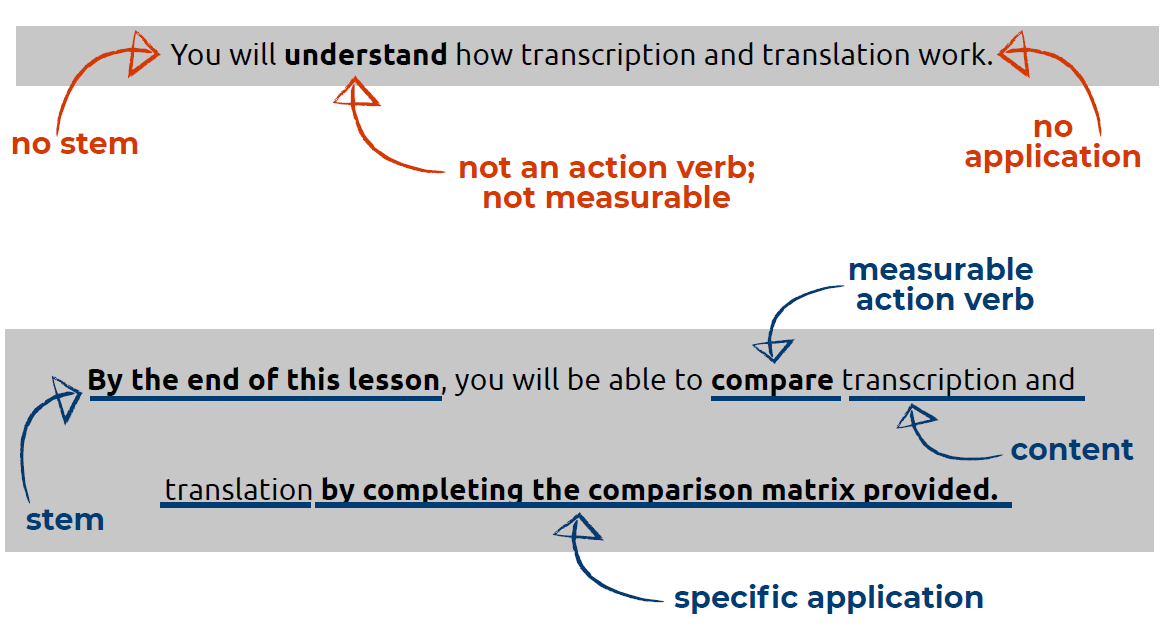Learning Outcomes
Definition
Learning outcomes describe the knowledge, skills or values that individual learners will demonstrate upon completion of a learning activity or experience. Learning outcomes exist at various levels: lesson, course, program, and degree. Learner-centered instruction requires clearly communicated outcomes about what learners will know, do, and value by the end of the course, unit or lesson. Therefore, all components of the course should be in support of these statements.

Explanation
Effective learning outcomes include four elements:
- The stem: 'By the end of this course (lesson, activity, etc.), you will be able to...'
- The action verb: Consider the various categories in Bloom's taxonomy, including remembering, understanding, applying, analyzing, evaluating, and creating.
- Demonstrated learning: The content or skill that will be assessed.
- Application: Clarify the context in which learners will achieve this outcome and any specific conditions (e.g., using a particular resource or method, or in a particular setting, etc.).
By the end of this [course, unit, session, workshop, class, activity, etc.], you will be able to [action verb] + [specific details of the learning] + [how it will be demonstrated].
Application
Best practices for developing and/or updating course learning outcomes:
- Use learner-focused language (e.g., 'By the end of this course, you will be able to...').
- Use action verbs. Avoid passive verbs that are difficult to measure (e.g., understand, know, learn, become familiar with)
- Consider the different categories of action in Bloom’s taxonomy; don’t focus solely on lower order thinking skills such as those related to remembering and understanding
- Use one verb per outcome
- Be very clear; refrain from using figures of speech
- Include only relevant outcomes that will be assessed
- Give your list to a colleague to provide feedback
Using Bloom's Taxonomy
Bloom's taxonomy refers to a framework to categorize educational goals. It was first developed by Benjamin Bloom and colleagues in 1956 and consisted of six categories: knowledge, comprehension, application, analysis, synthesis and evaluation. In 2001, Anderson and Krathwohl revised Bloom's taxonomy, making some structural changes and replacing the nouns in Bloom's categories with verbs.
The revised version of Bloom's taxonomy summarizes the process of learning, from lower order skills like remembering and understanding to higher order skills like evaluating and creating. You can use Bloom's taxonomy table to identify action verbs that align with each learning level. You can then incorporate these measurable verbs into learning outcomes to clearly indicate what the student must do to demonstrate learning. Avoid the use of non-measurable verbs, such as learn, understand, realize and know.
Examples
Effective learning outcomes include a stem, action verb, context and application. The image below provides an example of a weak learning outcome (top) and shows how it can be improved by employing an action verb and providing additional context (bottom).
The examples below align with each learning level in Bloom's taxonomy.
- Knowledge: By the end of this unit, you will be able to (stem) label (action) the 14 facial bones (learning) on a diagram (application/context).
- Understanding: By the end of this lesson, you will be able to (stem) compare (action) historic and modern treaty negotiations (learning) in a venn diagram (application/context).
- Apply: By the end of this course, you will be able to (stem) solve (action) algebraic equations (learning) using real-life examples (application/context).
- Analyze: By the end of this course, you will be able to (stem) analyze (action) restorative justice practices (learning) in case study examples (application/context).
- Evaluate: By the end of this lesson, you will be able to (stem) test for (action) the presence of protein in five food samples (learning) using the virtual Biuret’s test simulator (application/context).
- Create: By the end of this unit, you will be able to (stem) compose (action) a research-based five paragraph essay (learning) based on a topic of your choice (application/context).
Resources
Writing Intended Learning Outcomes - University of Waterloo
References
Bloom, B. S., Engelhart, M. D., Furst, E. J., Hill, W. H., & Krathwohl, D. R. (1956). Taxonomy of Educational Objectives, Handbook 1: Cognitive Domain. David McKay Company, Inc.
Krathwohl, D. R. (2002). A Revision of Bloom’s Taxonomy: An Overview. Theory into Practice, 41(4).

